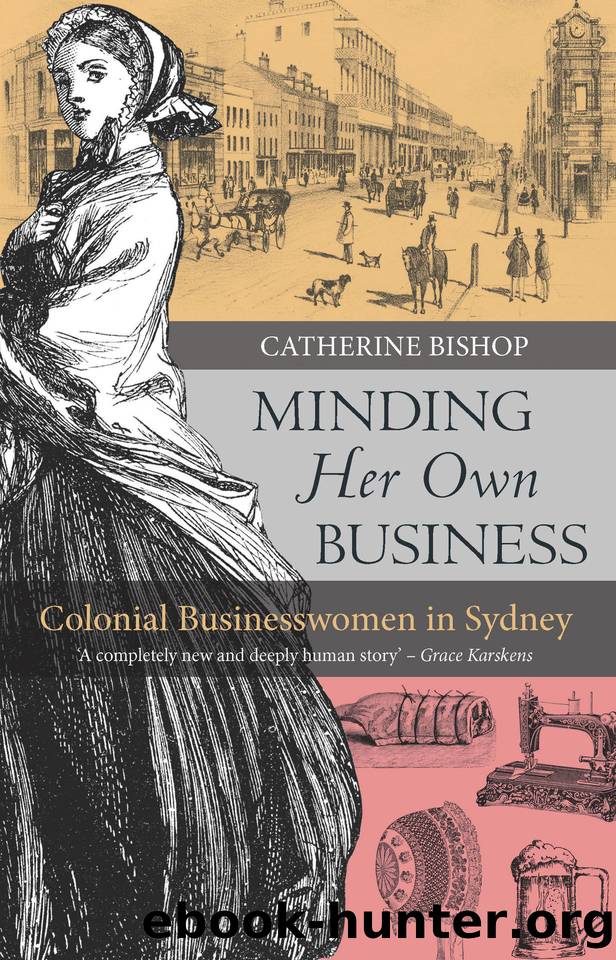Minding Her Own Business: Colonial Businesswomen in Sydney by Bishop Catherine

Author:Bishop, Catherine
Language: eng
Format: epub
Publisher: NewSouth
Published: 2015-10-02T00:00:00+00:00
âWe have changed servants againâ
âWe have changed servants again â¦â So wrote Rachel Henning, in a somewhat weary tone, to her sister from a pastoral station in Queensland in 1865. As we have seen, letters middle-class women wrote home to England from the colony in the nineteenth century were often a litany of complaints about the scarcity, incompetence and inappropriate boldness or âindependenceâ of domestic servants in New South Wales. In rural areas, Indigenous women and men were often employed as domestic servants, but in Sydney this seems to have been less common. Boatloads of young women, intended to be domestic servants, were given free passage from Britain and Ireland to the colonies. There were, however, few formal means of matching them with prospective employers once they arrived. This was particularly the case once they had settled in Sydney and were seeking a second or third position when either servant or mistress had proved unsatisfactory. Similarly, employers who did not want freshly disembarked servants, but preferred those with colonial experience, also needed a means of hiring help. Who better to organise the supply of that commodity than women?22
Caroline Chisholm, whom we met in chapter 3 running a school, is well known for arranging the immigration of female domestic servants from Britain to Sydney in the 1840s and 1850s. She then famously escorted cartloads of these young women around rural New South Wales, where women were still scarce, and offloaded them to eager farmers as domestic servants and prospective wives. Within Sydney, though, there were a number of other women who ran servants registry offices. Some were operated on a very small scale, in conjunction with a small shop or boarding house and with little more than a noticeboard, but others were long-lived and well known.
Mrs Eliza Cappsâ registry office operated in King Street from 1854 (see figure 22) and then in Castlereagh Street until 1874, when ownership passed to Ellen Crease. Originally from Longford, Ireland, Eliza Read arrived in Australia in 1848 on the Sir Edward Parry as a thirty-four-year-old widow with two young children. She was matron in charge of a number of Irish children, who were being reunited with their emigrant and convict parents in Australia. (The implementation of this government-funded program of sending children to join their parents was partly influenced by Caroline Chisholm.) Soon after arriving, Eliza Read married Englishman Edward Capps, who had been the schoolmaster on the immigrant ship.
Eliza Capps was then employed as matron in charge of the Irish female orphans at the Immigrant Depot at Hyde Park Barracks. Her new husband was a clerk, before being appointed postmaster at Sofala on the goldfields about 50 kilometres north of Bathurst in 1851. Eliza does not seem to have accompanied him, but remained in her position as matron until February 1854, when she opened her servants registry office. Unsurprisingly many of her clients were recently arrived immigrants. Domestic servants, nursemaids and governesses came to her seeking positions. She then advertised their availability in the
Download
This site does not store any files on its server. We only index and link to content provided by other sites. Please contact the content providers to delete copyright contents if any and email us, we'll remove relevant links or contents immediately.
| Africa | Americas |
| Arctic & Antarctica | Asia |
| Australia & Oceania | Europe |
| Middle East | Russia |
| United States | World |
| Ancient Civilizations | Military |
| Historical Study & Educational Resources |
Machine Learning at Scale with H2O by Gregory Keys | David Whiting(4176)
Never by Ken Follett(3788)
Fairy Tale by Stephen King(3219)
The Man Who Died Twice by Richard Osman(2996)
Oathbringer (The Stormlight Archive, Book 3) by Brandon Sanderson(2875)
Will by Will Smith(2791)
Rationality by Steven Pinker(2291)
The Dark Hours by Michael Connelly(2243)
Can't Hurt Me: Master Your Mind and Defy the Odds - Clean Edition by David Goggins(2225)
The Dawn of Everything: A New History of Humanity by David Graeber & David Wengrow(2122)
Friends, Lovers, and the Big Terrible Thing by Matthew Perry(2117)
Principles for Dealing With the Changing World Order: Why Nations Succeed and Fail by Ray Dalio(1971)
HBR's 10 Must Reads 2022 by Harvard Business Review(1776)
A Short History of War by Jeremy Black(1759)
Go Tell the Bees That I Am Gone by Diana Gabaldon(1687)
515945210 by Unknown(1599)
A Game of Thrones (The Illustrated Edition) by George R. R. Martin(1588)
Kingdom of Ash by Maas Sarah J(1522)
443319537 by Unknown(1467)
